Updated September 13, 2023
A standard residential lease agreement is a fixed-term rental contract between a landlord and a tenant that pays monthly rent for the use of the property. The term is most commonly for a one-year period. The tenant is obligated to pay the first month’s rent, security deposit, and any other fees at the time of executing the lease.
By State
- Alabama
- Alaska
- Arizona
- Arkansas
- California
- Colorado
- Connecticut
- Delaware
- Florida
- Georgia
- Hawaii
- Idaho
- Illinois
- Indiana
- Iowa
- Kansas
- Kentucky
- Louisiana
- Maine
- Maryland
- Massachusetts
- Michigan
- Minnesota
- Mississippi
- Missouri
- Montana
- Nebraska
- Nevada
- New Hampshire
- New Jersey
- New Mexico
- New York
- North Carolina
- North Dakota
- Ohio
- Oklahoma
- Oregon
- Pennsylvania
- Rhode Island
- South Carolina
- South Dakota
- Tennessee
- Texas
- Utah
- Vermont
- Virginia
- Washington
- Washington D.C.
- West Virginia
- Wisconsin
- Wyoming
Table of Contents |
What is a Residential Lease?
A residential lease is between a tenant that agrees to pay rent for the use of livable property.The landlord will accept rent, usually on a monthly basis, with a term that commonly lasts for 1-year.
What Should be Included?
Every lease should include these 3 main items:
- Term: Start and end dates.
- Rent ($): Usually per month, but can be on a daily or weekly basis.
- Deposits ($): Such as security deposit, pet deposit, etc.
When to Use?
A residential lease should be used when leasing any type of livable property to a tenant. This may include:
- Single-family homes;
- Apartments;
- Condos;
- Room rentals;
- Mobile homes; or
- Other residential dwellings.
The main purpose is to minimize disputes by having all agreements entered into a written contract.
How to Negotiate
Each tenant is unique and the following are major factors when negotiating a lease:
- Employment History – The landlord wants to see a long and stable job history that includes staying at each company for 3-5 years. Any less than that, or long periods of unemployment, will be deemed as high-risk to the landlord.
- Current Pay Stubs – In order to prove one’s income, the landlord would like to see the applicant’s last 2 weeks’ pay stubs. This can be either gathered directly from the employer or through a bank statement.
- Past Income – The applicant will need to gather their last 2-3 years income tax filings with the Internal Revenue Service (IRS). For employees, this would be Form W-2, for self-employed individuals or independent contractors, this would be Form 1099-NEC;
- Rent Pre-Payment – If the applicant can pay rent in advance at the start of the lease, there is a chance the landlord will agree to a lesser monthly amount. Especially if the amount is equal to more than 3 months;
- Security Deposit – Due to most States establishing a maximum security deposit amount, the tenant may not be able to take advantage of this to the fullest extent; and
- Landlord History – If the applicant has rented previously in their life, they should gather past landlord and property manager contact information as a viable reference.
Fixed Lease vs. Month-to-Month
Fixed Lease
- Fixed-term (start and end dates);
- Cannot end early; and
- Cannot change the agreement.
Month-to-Month Lease
- Renews every month (tenancy-at-will);
- Either party may terminate (in accordance with Month-to-Month Termination Laws); and
- The agreement can be changed with proper notice.
Frequently Asked Questions (7)
- Can the Landlord or Tenant Break a Standard Lease?
- How Long Does a Lease Last?
- Does a Lease Need to be Witnessed or Notarized?
- Can I add a Roommate to a Standard Lease?
- Can the Tenant Remain on the Property After the Lease Ends?
- Is it Possible to Transfer a Lease?
- What if the Landlord Violates the Lease?
Can the Landlord or Tenant Break a Lease?
The short answer is no. The landlord and tenant, unless there is a termination clause in the lease, cannot end the lease before the end date. Although, both parties have avenues they may pursue in order to attempt to cancel the agreement in an amicable manner.
- Offer a Payout – Negotiate with the tenant what it would take for them to move-out early. Start with returning their security deposit immediately and offering to pay for their moving costs.
- Offer Free Rent – If the landlord would like the tenant to move out in 2-3 months time, get the tenant to agree by offering them free rent until the early termination date.
- Offer the Security Deposit – Offer the landlord the security deposit as a good-faith effort to get out of the lease. This is at least a starting point and is generally more than what most tenants do.
- Offer an Extra Month’s Rent – If the tenant did not have to pay a security deposit at the beginning of the lease, the landlord may be inclined to take an extra month’s rent or equivalent payment to let the tenant out of the lease.
- Plead Financial Hardship – If the tenant can prove to the landlord that they have lost their job, in some cases, the landlord will offer a release rather than fight the tenant through an eviction.
- Claim Domestic Violence – In some States, like Nevada, there are laws that allow the tenant to break the lease without penalty if the tenant is a victim of domestic violence. Any tenant that is a victim of domestic violence should seek immediate help regardless of local laws.
How Long Does a Lease Last?
The length of time of a lease agreement is identified as one of the requirements of the contract. A lease agreement can be created for month-to-month leasing, six months, one year or more. Lease agreements are not required to be the same set amount of time. At the end of the current lease (fixed term) the landlord may wish to extend the lease to the tenant, as a lease agreement does not automatically renew, unlike a rental agreement. The current lease agreement will need to be amended or a new legally binding agreement can also be signed.
Does a Lease Need to be Witnessed or Notarized?
In all 50 States, a lease agreement does not need to be signed with a witness or notary public as long as it’s no more than a period of one (1) year. If longer, States like Florida, require additional signing requirements such as witnesses to be present.
Can I Add a Roommate to a Lease?
In the event the tenant is adding another individual to the residence (i.e. roommate, family member, etc.), the lease agreement should be consulted for requirements. Standard Residential Lease agreements have guidelines that new tenant additions be added specifically as a co-tenant. The additional tenant may be subject to criminal and financial screening, and rental history review. Furthermore, the current lease agreement may need to be reviewed to ensure the occupancy limit is not exceeded.
Can the Tenant Remain on the Property after Lease Expiration?
The tenant will have to read their lease, as most agreements automatically convert to a month-to-month lease (tenancy-at-will) if there is no termination by either party. In most cases, the landlord will send the tenant a Lease Extension Addendum before the original lease ends to extend the term. The extension will detail the new end date, along with any other changes while maintaining the rest of the terms of the original lease agreement.
Is it Possible to Transfer a Residential Lease?
Unless the agreement has assignment rights, a lease cannot be transferred to someone else. By default, most leases have language that specifically prohibits the assignment of a lease agreement.
Although, a common practice endorsed by landlords is to allow a tenant to sublet the property. In a Sublease Agreement, the tenant re-rents the property to another individual who pays rent to the tenant, who then pays the rent as stated in the original lease signed with the landlord. In most cases, the tenant must obtain permission from the landlord, via the Landlord Consent Form, before finding a sub-tenant for the property.
What if the Landlord Violates the Lease?
If the landlord violates the lease agreement, the tenant, subject to State law, must contact the landlord about the violation. If the landlord does not correct the issue, such as being unwilling to repair the premises, the tenant may be able to “fix” the issue themselves and deduct it from the rent or terminate the lease altogether.
How to Write (11 steps)
- Complete the Parties’ Information
- Describe the Property
- Rent Amount ($)
- Utilities and Services Responsibility
- Furnishings
- Lease Term
- Security Deposit
- Early Termination
- Smoking Policy
- Pets
- Lead-Based Paint Disclosure
1. Complete the Parties’ Information
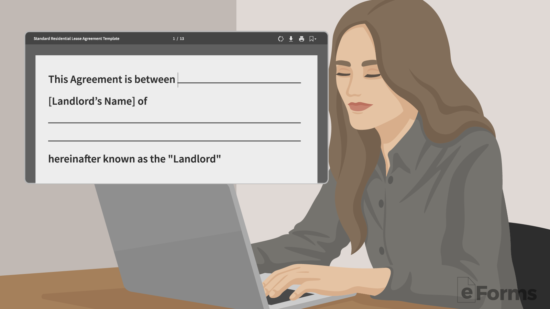 Download: PDF, Microsoft Word, Open Document Text
Download: PDF, Microsoft Word, Open Document Text
Otherwise known as the “landlord” and “tenant”, decide who will be named in the lease. This is an important question that is asked of tenants that will be living together, such as those in a romantic relationship. A general rule is if both persons’ incomes can only support the rent, then it’s advised that both individuals are named as tenants.
If there are children or anyone that won’t be listed as a tenant but living on the property, they will be named as ‘occupants’.
2. Describe the Property
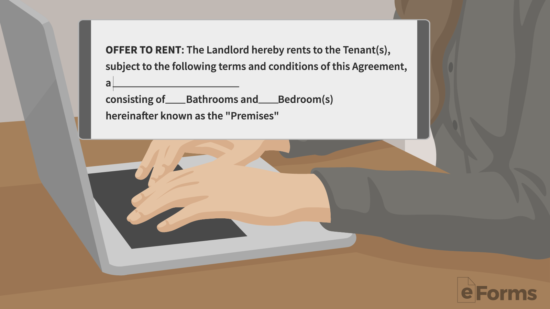 As the tenant, he or she will want to know what is expressly included in the lease. If the property is a condominium, for example, the tenant should ensure that it’s included that he or she will have access to all facets of the property during the term.
As the tenant, he or she will want to know what is expressly included in the lease. If the property is a condominium, for example, the tenant should ensure that it’s included that he or she will have access to all facets of the property during the term.
In addition, if the property includes parking or any other services that are available and accessible by the tenant, it should be included in the agreement.
3. Rent Amount ($)
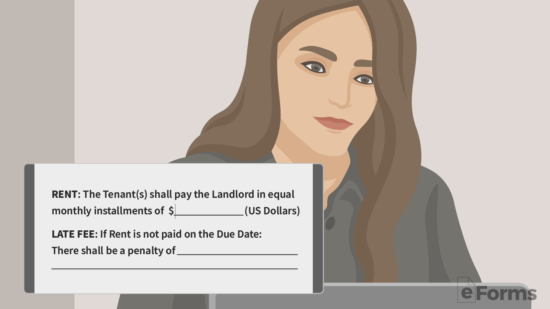 Before agreeing to a rent amount it’s a good idea to do a last check of the surrounding area to view the monthly amount being offered by other landlords. This can be done using RentoMeter which utilized third (3rd) party resources in order to inform a prospective tenant if they are paying too much by giving the median rent for a market area.
Before agreeing to a rent amount it’s a good idea to do a last check of the surrounding area to view the monthly amount being offered by other landlords. This can be done using RentoMeter which utilized third (3rd) party resources in order to inform a prospective tenant if they are paying too much by giving the median rent for a market area.
It’s important to read what is included as part of the rent, such as utilities and services, as well as how the payment is to be made and which day of the month it’s due.
Late Fees – If there are going to be any late fees it should be clearly established between the landlord and tenant. Most often there is either a fee for each day payment is late or for each occurrence. Some States have maximum limits so it’s best to perform a search of the laws where the property is located.
4. Utilities and Services Responsibility
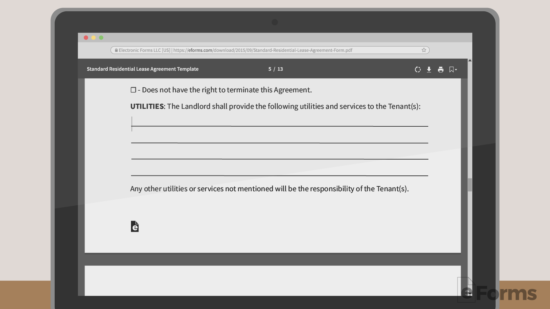 Almost as important as the monthly rent are the utilities and services that are included in the lease. Depending on the area of the property, utilities and services are vital for the everyday life of the tenant including:
Almost as important as the monthly rent are the utilities and services that are included in the lease. Depending on the area of the property, utilities and services are vital for the everyday life of the tenant including:
Examples Include:
- Electricity
- Trash / Recyclables
- Water / Sewer
- Cable / Internet
- Heat (gas, propane, etc)
- Air Conditioning
- Lawn Care (suburban areas)
- Snow Removal (suburban areas)
5. Furnishings
 Make sure that every appliance and piece of furniture that is mentioned in the lease exists on the property. If not, at the end of the agreement the landlord will be liable to claim whatever is mentioned in the lease as part of the property. If a move-in checklist is being completed, this is not a huge issue, but the tenant should double-check to ensure that all is included as part of the lease.
Make sure that every appliance and piece of furniture that is mentioned in the lease exists on the property. If not, at the end of the agreement the landlord will be liable to claim whatever is mentioned in the lease as part of the property. If a move-in checklist is being completed, this is not a huge issue, but the tenant should double-check to ensure that all is included as part of the lease.
7. Security Deposit
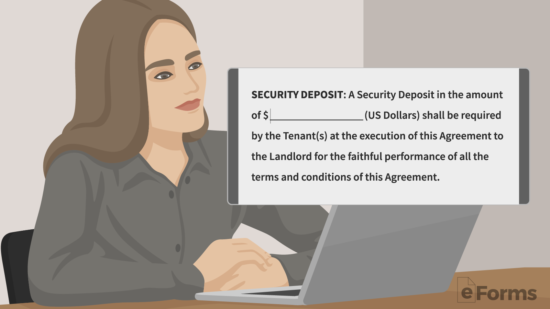 A security deposit is an amount of money that is held in an escrow account by the landlord. The funds are fully released to the tenant, at the end of the agreement, pending there is no damage to the property. The security deposit is a safety net for the landlord in case the tenant decides to not pay rent, vacate the property early, or if at the end of the term there is damage to the premises. If there is damage to the property at the end of the lease, the landlord will usually provide an itemized list of all repairs that were made and their amount.
A security deposit is an amount of money that is held in an escrow account by the landlord. The funds are fully released to the tenant, at the end of the agreement, pending there is no damage to the property. The security deposit is a safety net for the landlord in case the tenant decides to not pay rent, vacate the property early, or if at the end of the term there is damage to the premises. If there is damage to the property at the end of the lease, the landlord will usually provide an itemized list of all repairs that were made and their amount.
- Maximum Amounts ($) – Limits required by law for each State.
- Returning the Security Deposit – The landlord will be obligated to return the security deposit to the tenant within the State required time period.
8. Early Termination
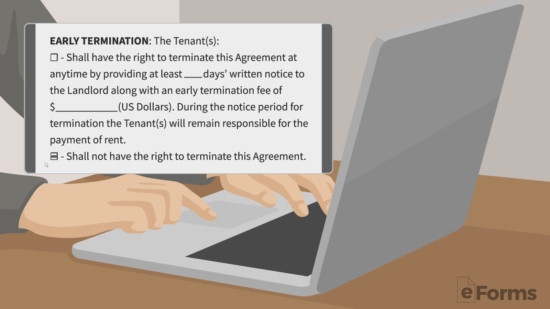 If the landlord and tenant decide to allow for the termination of the agreement it can either be done with or without a fee by either party. If a fee is required, it’s commonly equal to one (1) month’s rent and gives the other party thirty (30) days’ notice. This section can be entirely negotiated between the landlord and the tenant. There are no State laws or requirements that restrict this section.
If the landlord and tenant decide to allow for the termination of the agreement it can either be done with or without a fee by either party. If a fee is required, it’s commonly equal to one (1) month’s rent and gives the other party thirty (30) days’ notice. This section can be entirely negotiated between the landlord and the tenant. There are no State laws or requirements that restrict this section.
10. Pets
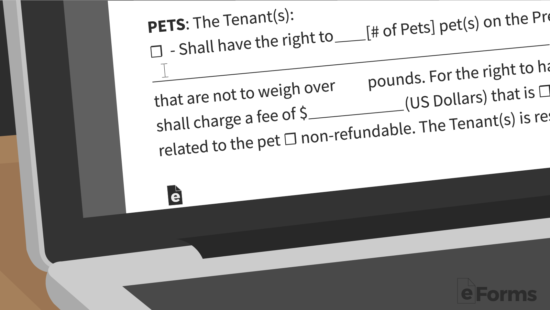 While technically considered an occupant, pets are not a landlord’s best friend. Even if they are allowed on the property, the landlord should state exactly which types are allowed so that an “organic” tenant doesn’t have farm animals on the premises. Furthermore, it’s recommended that the landlord place a maximum weight the animal may be for liability (dangerous dogs tend to be larger) and damage to the premises.
While technically considered an occupant, pets are not a landlord’s best friend. Even if they are allowed on the property, the landlord should state exactly which types are allowed so that an “organic” tenant doesn’t have farm animals on the premises. Furthermore, it’s recommended that the landlord place a maximum weight the animal may be for liability (dangerous dogs tend to be larger) and damage to the premises.
In most states, a landlord is allowed to charge an additional pet fee or deposit that is separate from the security deposit. A landlord may use the Pet Lease Addendum to set rules for animals on their property.
11. Lead-Based Paint Disclosure

Perhaps the most important disclosure is to identify to a new tenant the existence of lead-based paint on the premises. Under federal law (42 U.S. Code § 4852d), if the structure on the property was built prior to 1978, the landlord will be required to issue the disclosure to the tenant. The disclosure casts a warning to the tenant that if they should see any chipping, deteriorating, or cracking paint on the premises to contact the landlord and authorities immediately.

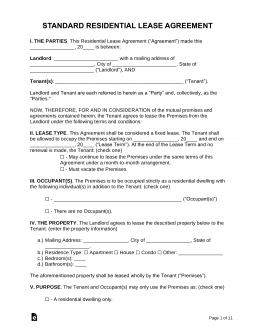
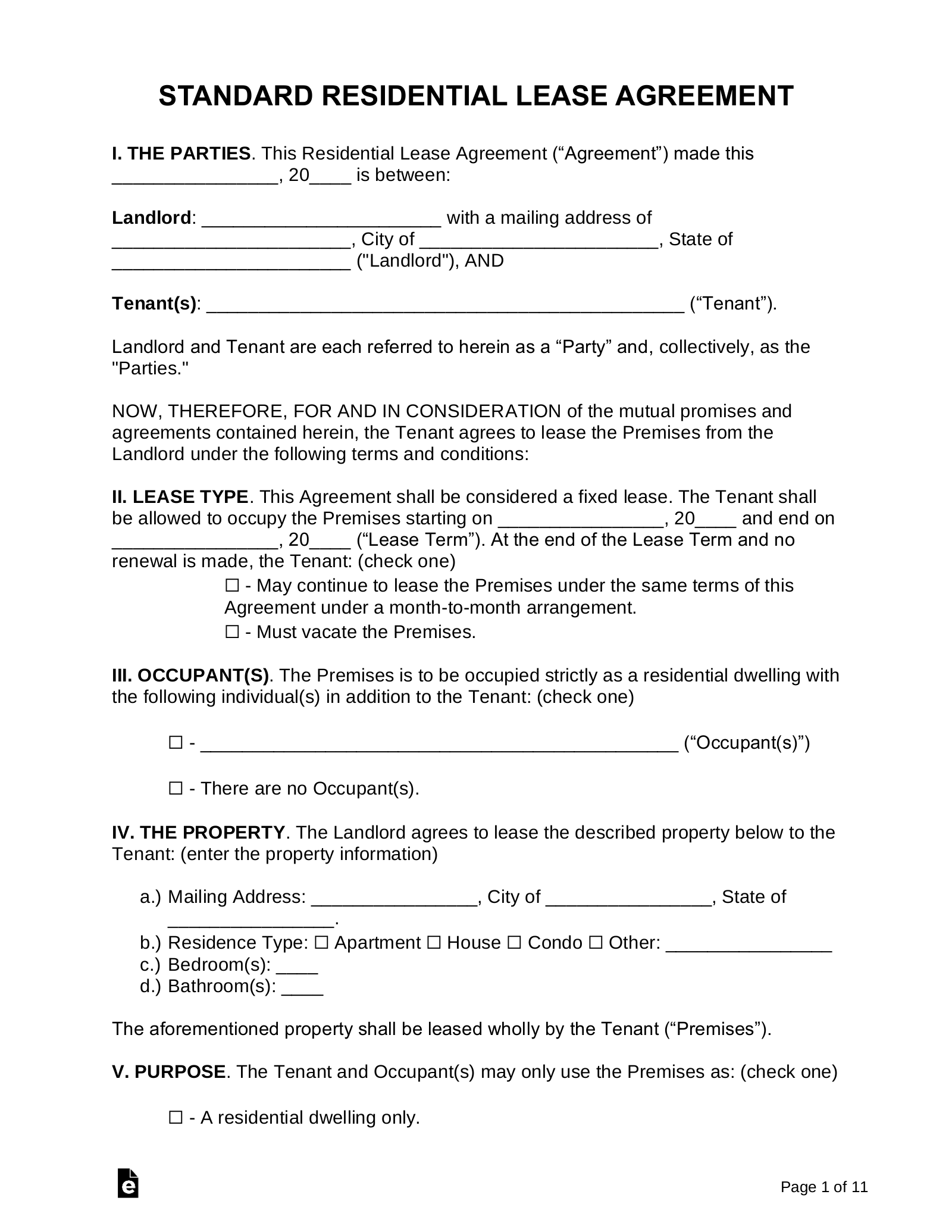
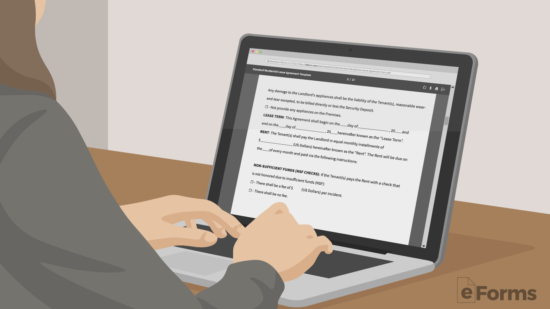 In most cases, a standard lease has a term of 12 months. Although, in some situations, such as if the tenant has employment restrictions or other matters, the agreement can be made for any fixed time period. The tenant should enter the term that works best for their situation.
In most cases, a standard lease has a term of 12 months. Although, in some situations, such as if the tenant has employment restrictions or other matters, the agreement can be made for any fixed time period. The tenant should enter the term that works best for their situation.
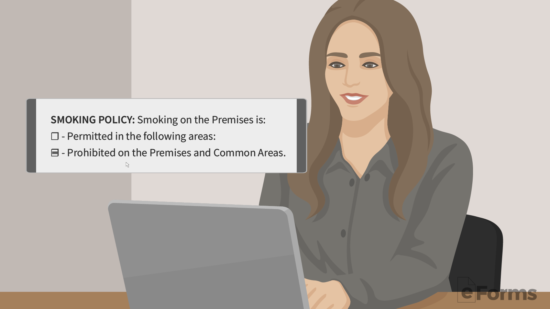 If there is a smoking policy, it must be mentioned in the agreement. By default, if it’s not stated that the act is prohibited, the tenant may have the right to smoke. In California for example, it’s required that every lease mention what the policy is on the premises.
If there is a smoking policy, it must be mentioned in the agreement. By default, if it’s not stated that the act is prohibited, the tenant may have the right to smoke. In California for example, it’s required that every lease mention what the policy is on the premises.